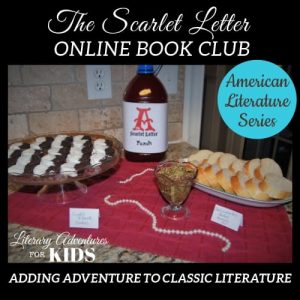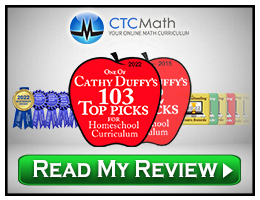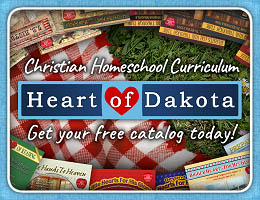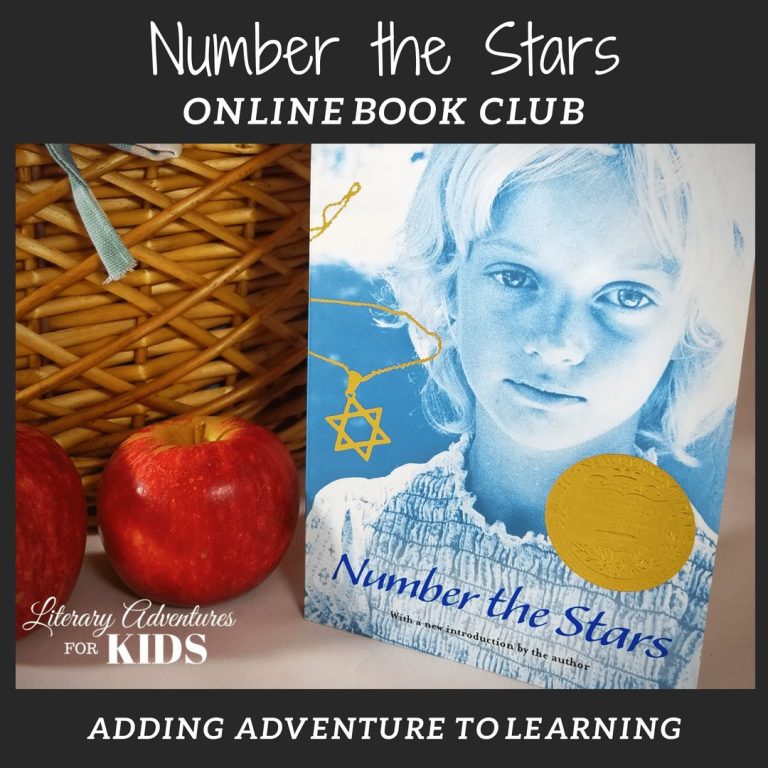The Online Book Clubs from Literary Adventures for Kids aren't clubs in the usual sense. Instead, these are guides for the study of novels and plays that include the rest of your language arts curriculum. The studies are presented online but do not require students to meet up with others online or to work with other students. However, there are many activities for parents and students to use within groups or their own families. Of course, students can join a group class, something I highly recommend since students are likely to enjoy the studies more if they can meet periodically with others.
Each study should take a month to complete, although I can envision adding an extra week to plan and execute the party at the end of each study. If you work with other families, you might meet weekly or only for the culminating party for each study.
This review focuses on studies for middle school through high school. You can read my review of the Online Book Clubs for the elementary grades here.
The Online Book Clubs started out as guides for studying novels, with some other aspects of language arts included. They've been expanded to include grammar, spelling, and composition to the point where a bundle or series of eight to ten Book Clubs can serve as your complete language arts program for a year. Literary Adventures for Kids also offers supplemental courses, such as How to Write a Research Paper, which is included within memberships, and Creative Writing, a live course offered at extra cost.
The numerous online Book Clubs are generally grouped by levels or topics, such as Year 7 Curriculum and British Literature. You can purchase individual Book Clubs or a bundle (predesigned or ones you choose). You need to obtain the literary work for each study on your own. Purchased Book Clubs are yours forever. Memberships are also available as described below. The benefit of purchasing a predesigned series (or using one within a membership) is that the language arts skills have been arranged within each series to assure more coverage of skills and less duplication.
The Book Clubs are written from a secular perspective. Some books might have content that some parents think is too mature for their teens, so parental discretion is required.
Memberships
Memberships give you access to Book Clubs for the duration of your subscription. The Readers' Guild membership is the most comprehensive, giving you access to almost 200 courses for all grade levels. You can use one membership for all children in your family. The Clubhouse membership gives you access to more than 100 courses for elementary and middle school. For high school, the Society of Literary Adventurers membership grants access to almost 100 courses, including Book Clubs, some special courses, and unit studies. All memberships provide you with instructor feedback, live office hours for asking questions, a monthly interactive book club with a live group meeting online, live monthly poetry teatimes, workshops for parents, community support, and more. Scroll to the bottom of this page on the publisher's website for a chart comparing the three memberships. In addition to the perks, memberships make it easy to switch Book Clubs if a particular book isn't working out, and you've got a vast array to choose from.
Middle School Studies
Many Book Clubs are designed for students in middle school through high school but are best for middle school. Studies that are written only for high school are reviewed in the second part of this review. Those best for middle school are for novels such as:
- A Wrinkle in Time
- The House with a Clock in Its Walls
- Wonder
- The Birchbark House
- Holes
- Where the Red Fern Grows
- Bud, Not Buddy
- Number the Stars
- Mary Poppins
- Love That Dog
- Doctor Dolittle
- Brown Girl Dreaming
- Inside Out & Back Again
- Enola Holmes
- I Am Malala
- The Little Prince
Some of these are grouped within one or more of the suggested series. For instance, I Am Malala and The Little Prince are also listed as part of the World Literature series for middle school.
Online lesson plans guide you through each study. On your lesson plan dashboard, outlines are always visible on the left-hand navigation bar, and the selected part of the plan is displayed on the right.
Projects are a part of the studies, so a project resources list shows what you will need for each individual project in that study. After this, the menu shows lessons laid out for four or more weeks plus a culminating party.
Each novel is broken down into a manageable number of chapters to read for each section of a study. Some studies are clearly laid out for four weeks. Others, such as the Number the Stars Book Club, present lessons in parts rather than weeks. In this case, there are eight parts. You might complete two per week, although you could stretch the study out over eight weeks.
Students first read the assigned number of chapters. As they read, they are supposed to write down in their journal any sentences they particularly like or that have special meaning to them. They should also write down unfamiliar vocabulary words and look up their meanings. Students will also copy a passage from the novel, paying attention to spelling, capitalization, and punctuation.
“Rabbit trails” and “magic dust” might also be included in the lesson plan for each group of chapters. Rabbit trails are topics to explore that are tangential to the story. Number the Stars has many rabbit trails with as many as six in just one section of the study. For example, for the first week of that study, five rabbit trails cover the topics of Copenhagen, Hans Christian Andersen, King Christian and the Monarchy, the Nazis and Hitler, and Surrender of Denmark to Germany. Online resources provide information on these topics. Students can then type in their own comments to post on the web page, although this is optional. Magic dust activities are hands-on projects such as those for Number the Stars: finger crocheting, paper stars, making overnight oats, and creating a newspaper. Instructions are included.
The studies include a writing project. For example, in the Number the Stars study, the eighth part has a “Writing and Literary Elements” section that provides brief instruction and options for a writing assignment.
Yet another set of weekly activities varies from study to study, usually including an interactive activity among them. For example, in the Number the Stars study, each part concludes with a foreign language section where students will learn some basic vocabulary from either the Hebrew or Danish language, both of which relate to the story.
Each Online Book Club concludes with what is called “Party School.” The lesson plan suggests food, decorations, and activities for this culminating party. The party can be great fun, especially if students do much of the planning and execution.
Studies for High School Level
 Examples of individual Book Clubs for high school are those for studying the books:
Examples of individual Book Clubs for high school are those for studying the books:
- Eagle of the Ninth
- Crime and Punishment
- Emma
- Fahrenheit 451
- Frankenstein
- Hamlet
- The Scarlet Letter
- The Great Gatsby
There are six series of Book Clubs, five of which can serve as complete high school courses. Suggested grade levels follow each series title:
- Poetry and a Movie (9th grade)
- American Classic Literature series (10th grade)
- British Classic Literature series (11th grade
- World Literature series (12th grade)
- Modern Literature (any grade)
- Shakespeare series (one semester course for any grade)
I review the Poetry and a Movie series separately since it is quite different than the other series. The other high school series each include 10 Online Book Clubs per year.
The studies for American Literature are for the books The Scarlet Letter by Nathaniel Hawthorne, Up From Slavery by Booker T. Washington, Of Mice and Men by John Steinbeck, The Great Gatsby by F. Scott Fitzgerald, To Kill A Mockingbird by Harper Lee, Fahrenheit 451 by Ray Bradbury, Slaughterhouse-Five by Kurt Vonnegut, The Outsiders by S.E. Hinton, Little Women by Louisa May Alcott, and The Call of the Wild by Jack London.
The British literature series includes studies for Alice in Wonderland, A Tale of Two Cities, A Midsummer Night's Dream, Murder on the Orient Express, Emma, Animal Farm, The Hound of the Baskervilles, Sir Gawain and the Green Knight, The Eagle of the Ninth, and Frankenstein.
World literature has a very multicultural selection of books: I am Malala, The Boys in the Boat, Refugee, The Book Thief, The Alchemist, The Boy Who Harnessed the Wind, A Long Way Home, Balzac and the Little Chinese Seamstress, Crime and Punishment, and Midnight's Children.
The Modern Literature series includes Book Clubs for The Ballad of Songbirds and Snakes, Miss Peregrine's Home for Peculiar Children, The Lightning Thief, The Complete Maus, Speak, The Giver, Unwind, Under the Mesquite, I Must Betray You, and Modern Parables.
The Shakespeare study covers four plays: A Midsummer Night's Dream, Twelfth Night, Romeo and Juliet, and Macbeth.
The high school studies take students deeper into literary analysis, literary devices, intertextual connections, and authors' intentions through weekly lessons. Critical thinking assignments and “Questions to Ponder” push students beyond surface understanding. Formal essays or more complex writing assignments (e.g., narrative, analytical, or research-based) are tied to the literary work.
Students take online quizzes for vocabulary and sometimes for grammar. Parents can use those scores toward a grade, along with evaluations of copywork, dictation, and writing assignments. Students can submit their work to Literary Adventures for Kids for evaluation of their responses to free writing, Questions to Ponder, and writing projects by entering their work in the comments section of the pertinent lesson pages. However, parents can evaluate students' written work using the rubrics for essays and creative writing provided in the membership guides. (Another reason to get a membership.) The guides include other helpful information for curriculum planning, grading students' work, and more.
My review of the study for The Great Gatsby from the American Literature course shows how these studies work.
The Great Gatsby Online Book Club
The Great Gatsby and the other high-school-level Online Book Club studies are like the younger-level studies in many ways. However, high school studies have several additional features.
Generally, the novel is all that is required, but sometimes there's an extra book. For example, along with The Great Gatsby study (and some of the other studies), students will also read from the book Breakfast on Mars and 37 Other Delectable Essays, an inspiring and entertaining help for essay writing.
Lessons are divided into plans for four weeks, with each week following the same sequence, with a few exceptions.
The first of the weekly lesson plans begins with background information. For The Great Gatsby, this includes two YouTube® videos: a mini-biography of the author, F. Scott Fitzgerald, and The Roaring 20s: Crash Course US History #32.
The next section of the lesson plan (typical for the first lesson for the next three weeks) is titled "Read, Write, Learn." It directs students to read the first three chapters of the book. As they read, they are to write sentences or paragraphs that stand out to them in their journal, at least one passage per chapter. They also look up and write definitions for unfamiliar words. For the "Learn" component, they have an extended lesson on plot arcs that includes a Plot Chart Graphic Organizer they will use throughout the study.
The second repeating section of the weekly lesson plan is "Vocabulary and Spelling." It lists vocabulary words from the first three chapters, although it doesn't require students to write them with their definitions. Instead, online flashcards with five possible study modes are embedded in the lesson plan. Students might also want to practice writing those words while studying them for vocabulary since the spelling component pronounces the words and tells students to type what they hear.
Next, a grammar lesson usually has a link to an article on the GrammarBook site. Students will later apply what they learn in the “Show What You Know” section at the end of the week's lesson.
Every week includes one or more "rabbit trails," explorations of topics related to the story. For example, the first week of the study of The Great Gatsby has three rabbit trails. The first explains the settings of East Egg and West Egg in the story. The second explains Fitzgerald's allusion to Castile, "...and shawls beyond the dreams of Castile." The third has two short YouTube videos about Ford Motor Company and the Model T.
A "magic dust" hands-on project or activity each week adds some fun. In the first week of this study, students can learn to dance the Charleston with instruction via a video.
"Questions to Ponder," a set of literary analysis questions, are intended for discussion with a teacher or group. The questions are followed by a "Freewriting" assignment that tells students to choose one of the questions and write in response to it for a set amount of time. (This isn't a polished essay.)
A month-long writing project is introduced in the first week. For the first week, students are to begin the process of writing an essay about a theme in the novel. To assist them, the lesson includes an assignment to read from Breakfast on Mars and 37 Other Delectable Essays and watch a video about themes. Students can submit their writing projects for a teacher to critique by entering them in the "Comment" section on the lesson page.
“Show What You Know” sections at the end of each week’s lesson plan assess what students have learned, both by using dictation and editing exercises and by having students relate examples of literary terms they found in their reading. Students also complete grammar and vocabulary quizzes online.
The high school studies provide significantly more academic content than those that can be used for middle school through high school, but they still include the fun elements: rabbit trails, magic dust, and the party.
Note: While these studies can suffice for an entire year of language arts, some high school students might also require additional instruction in grammar or composition if they are deficient in those areas.
Summary
I particularly like the way these Online Book Clubs take advantage of internet resources and activities to enhance the study of novels and other aspects of language arts. The inclusion of spelling, grammar, vocabulary, literary analysis, and composition work means that a bundle of these studies can serve as your complete language arts coursework for middle school through high school.









